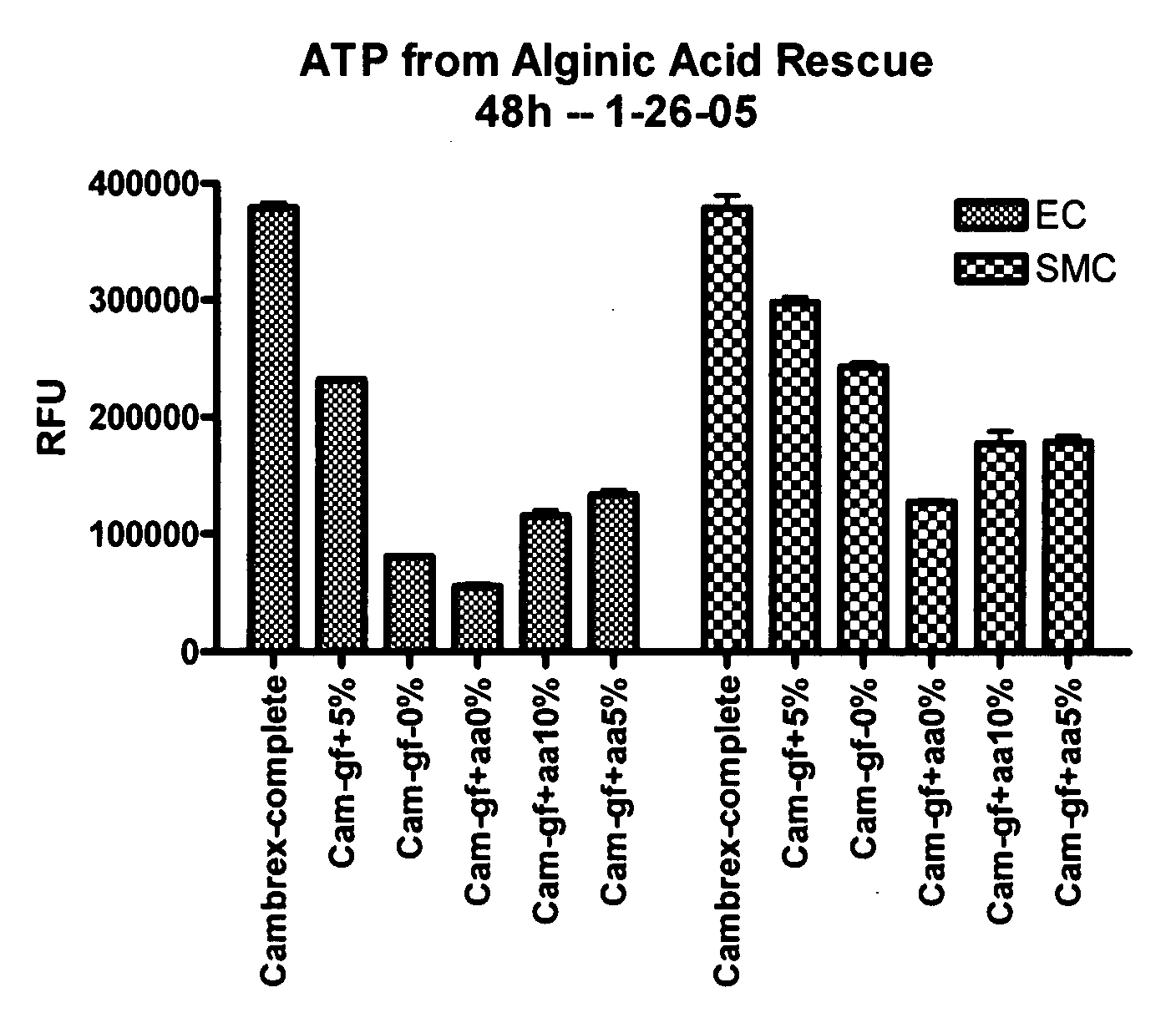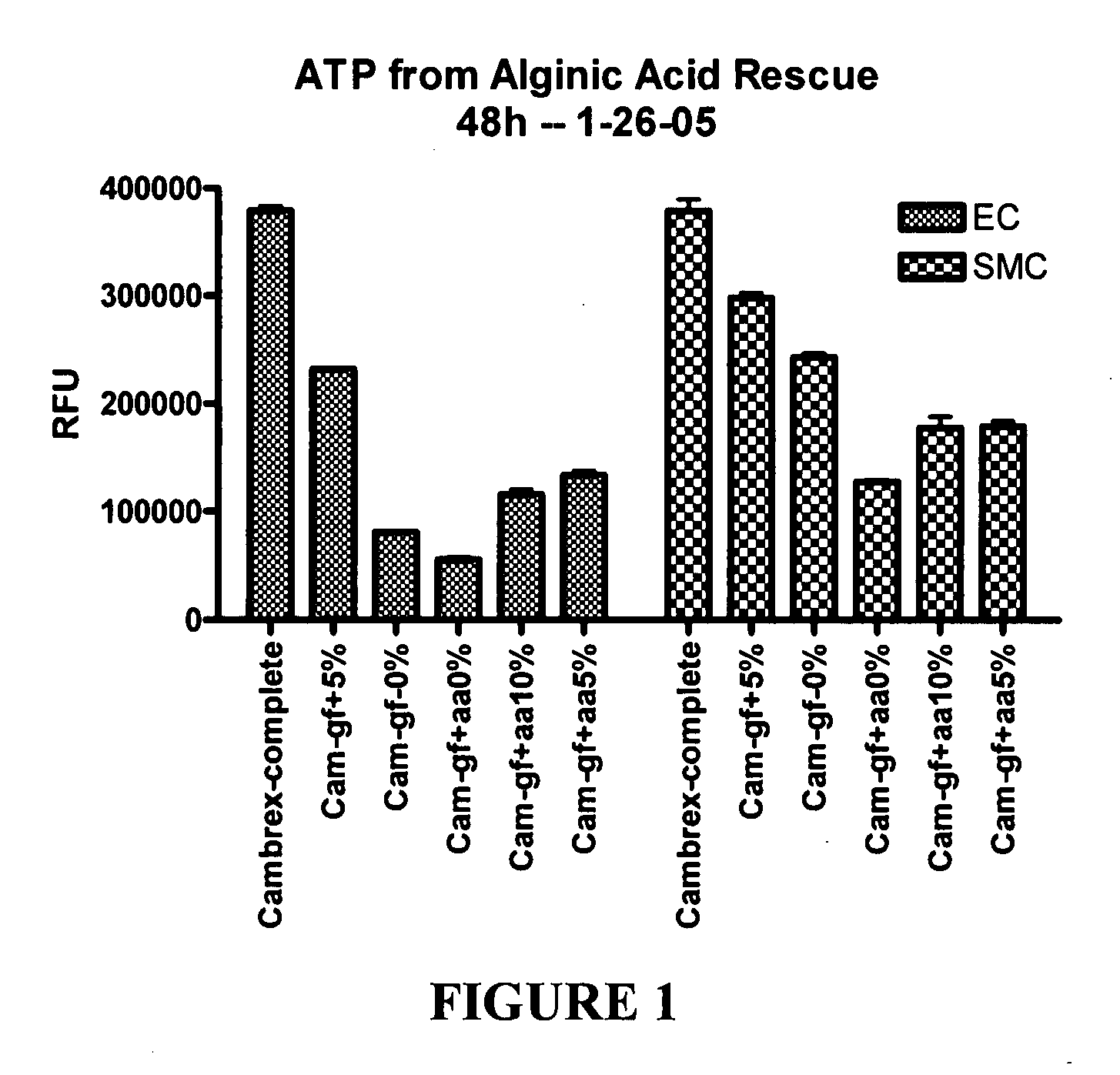Bioactive wound dressings and implantable devices and methods of use
- Summary
- Abstract
- Description
- Claims
- Application Information
AI Technical Summary
Benefits of technology
Problems solved by technology
Method used
Image
Examples
example 1
Delivery of Growth / Survival Components by Alginic Acid
[0260] This example illustrates experiments that were conducted to test the ability of hydrogel particles to deliver components required for cell growth and survival. The hydrogel particles were formed using low viscosity alginic acid (AA) (Sigma Chemicals, A2158) prepared using an adaptation of a published protocol (J Raymond et al., Am J Neuroradiol (2003) 24:1214-1221).
[0261] Preliminary experiments demonstrated that 4% low viscosity alginate made up in 0.5% sodium chloride can absorb about one third of its volume of the desired media, such as conditioned medium from progenitor cell cultures that had been isolated from human blood, and then be crosslinked by adding 5% calcium chloride. Polymerization occurs very rapidly and AA particles form, encapsulating the media within the alginate. The rate of release of media from the particles during the first 24 hours is very rapid, with about half of the media being released. The r...
example 2
Encapsulation of Cells in Hydrogel
[0275] A highly purified and well-characterized sodium alginate with very low levels of endotoxins and proteins, optimal for in vitro and in vivo applications, was used to encapsulate cells (NovaMatrix, Pronova UltraPure (UP) LVM alginate). This alginate is made up in 2% HEPES with some sonication, to help the AA go into complete suspension, and then filter sterilized. Cell-containing-particles are made by mixing cells plus fetal bovine serum (FBS) with the alginate, drawing the mixture up into a 1 cc syringe and forming particles drop wise into a 5% calcium chloride solution. This process produces about 100 particles / ml with about 2000 cells / particle. The cells used for this experiment were SMCs, which are a robust, anchorage-dependent cell line normally not grown in suspension.
[0276] To determine cell viability within the AA particles, two viability dyes were used: (1) Calcein AM, which is retained in cells that have intact membranes. Calcein A...
example 3
Polymer Coating of Hydrogel Encapsulated Cells
[0279] PEA conjugated to fluorescent dansyl-lysine was used to coat particles to visualize the polymer coating for consistency and completeness of coating. The results of this experiment indicated that a reliable method to coat AA particles to achieve consistency and completeness of coating was to suspend them in the polymer and allow the polymer to flow through a mesh that captures the particles. The particles were then rapidly removed from the mesh by resuspending in the appropriate buffer.
[0280] Then, to determine if the SMCs contained in AA particles can survive coating with PEA.H polymer, AA particles were formed containing 2000 smooth muscle cells / particle. Test AA particles were coated with a 10% (w / v ethanol) polymer solution and incubated in the presence of the two viability dyes shown in Example 2 above as able to enter the encapsulated cells. Control particles encapsulated the SMCs, but were also exposed to the dyes, but we...
PUM
| Property | Measurement | Unit |
|---|---|---|
| Time | aaaaa | aaaaa |
| Time | aaaaa | aaaaa |
| Biological properties | aaaaa | aaaaa |
Abstract
Description
Claims
Application Information
 Login to View More
Login to View More - R&D
- Intellectual Property
- Life Sciences
- Materials
- Tech Scout
- Unparalleled Data Quality
- Higher Quality Content
- 60% Fewer Hallucinations
Browse by: Latest US Patents, China's latest patents, Technical Efficacy Thesaurus, Application Domain, Technology Topic, Popular Technical Reports.
© 2025 PatSnap. All rights reserved.Legal|Privacy policy|Modern Slavery Act Transparency Statement|Sitemap|About US| Contact US: help@patsnap.com



